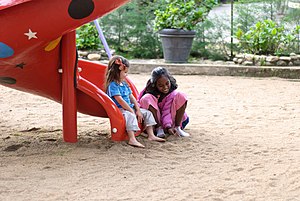
Back Einstellung (Psychologie) ALS اتجاه (علم النفس) Arabic Münasibət (psixologiya) Azerbaijani باخیم AZB Устаноўка (псіхалогія) Byelorussian Нагласа Bulgarian অভিব্যক্তি (মনোবিজ্ঞান) Bengali/Bangla Actitud Catalan Einstellung (Psychologie) German Actitud Spanish
This article has multiple issues. Please help improve it or discuss these issues on the talk page. (Learn how and when to remove these messages)
|

An attitude "is a summary evaluation of an object of thought. An attitude object can be anything a person discriminates or holds in mind." Attitudes include beliefs (cognition), emotional responses (affect) and behavioral tendencies (intentions, motivations). In the classical definition an attitude is persistent, while in more contemporary conceptualizations, attitudes may vary depending upon situations, context, or moods.[1]: 13
While different researchers have defined attitudes in various ways, and may use different terms for the same concepts or the same term for different concepts, two essential attitude functions emerge from empirical research. For individuals, attitudes are cognitive schema that provide a structure to organize complex or ambiguous information, guiding particular evaluations or behaviors. More abstractly, attitudes serve higher psychological needs: expressive or symbolic functions (affirming values), maintaining social identity, and regulating emotions. Attitudes influence behavior at individual, interpersonal, and societal levels.[1]: 13–16 Attitudes are complex and are acquired through life experience and socialization. Key topics in the study of attitudes include attitude strength, attitude change, and attitude-behavior relationships. The decades-long interest in attitude research is due to the interest in pursuing individual and social goals, an example being the public health campaigns to reduce cigarette smoking.[2]: 1–14
- ^ a b Bohner, Gerd; Wanke, Michaela (2011). Attitudes and Attitude Change. Frontiers of Social Psychology (1 ed.). London: Taylor and Francis. doi:10.4324/9781315784786. ISBN 9781315784786.
- ^ Albarracín, Dolores, ed. (2021). "Chapter 1 Definitions, Overview, Goals, and Principles of Cognitive Processing". Action and Inaction in a Social World: Predicting and Changing Attitudes and Behavior. Cambridge: Cambridge University Press. pp. 1–42. ISBN 978-1-108-84000-2. Retrieved 2023-12-09.